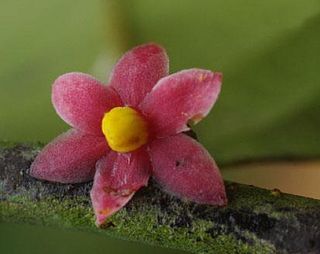
The Annonaceae are a family of flowering plants consisting of trees, shrubs, or rarely lianas commonly known as the custard apple family or soursop family. With 108 accepted genera and about 2400 known species, it is the largest family in the Magnoliales. Several genera produce edible fruit, most notably Annona, Anonidium, Asimina, Rollinia, and Uvaria. Its type genus is Annona. The family is concentrated in the tropics, with few species found in temperate regions. About 900 species are Neotropical, 450 are Afrotropical, and the remaining are Indomalayan.

Annona is a genus of flowering plants in the pawpaw/sugar apple family, Annonaceae. It is the second largest genus in the family after Guatteria, containing approximately 166 species of mostly Neotropical and Afrotropical trees and shrubs.
Hexalobus mossambicensis is a species of plant in the Annonaceae family. It is endemic to Mozambique.
Hexalobus salicifolius is a species of flowering plant in the family Annonaceae. It is found in Cameroon, Ivory Coast, Gabon, and the Republic of the Congo. Local common names include oouè, owoé, and owui.
Mkilua is a genus of plant in the family Annonaceae. It is native to Kenya and Tanzania. It contains a single species, Mkilua fragrans. Bernard Verdcourt, the British botanist who first formally described the species, named it after the fragrance of its flowers which smell like lemon. M. fragrans is monotypic. It is commonly called Mkilua Mwitu, Kilua and Kiluwa in Swahili, and Kingade in Digo. Volatile oils extracted from its leaves, flowers, and aerial parts have been reported to be repellent to Anopheles gambiae mosquitoes which are vectors for the malaria parasite Plasmodium falciparum. Bioactive molecules extracted from its roots have been reported to have antimicrobial activity in tests with Streptococcus agalactiae and Staphylococcus aureus.
Monocyclanthus is a monotypic genus of flowering plants in the family Annonaceae containing the single species Monocyclanthus vignei. It is native to Ghana and Liberia. It is a rare plant of the understory of wet evergreen forest habitat.

Popowia is a genus of flowering plants in the family Annonaceae. There are about 50 species distributed in tropical Asia and Africa and in Oceania.
Uvariopsis vanderystii is a species of plant in the Annonaceae family. It is found in Cameroon, the Democratic Republic of the Congo, and Gabon. Its natural habitat is subtropical or tropical moist lowland forests. It is threatened by habitat loss.

Sirdavidia is a monotypic genus of flowering plants from the family Annonaceae described February 4, 2015, by Thomas L.P. Couvreur of France's Institute of Research for Development, Raoul Niangadouma of the Herbier National du Gabon, Bonaventure Sonké of the University of Yaoundé, and Hervé Sauquet of Université Paris-Sud. The genus was named in honor of Sir David Attenborough. The type species Sirdavidia solannona was discovered and collected in Gabon in Crystal Mountains National Park on November 15, 2013, at elevations of 300–600 meters. The species name refers to the resemblance of the flowers to those of Solanum species.
Xylopia vielana is a tree species described by Pierre; it is included in the genus Xylopia and family Annonaceae. No subspecies are listed in the Catalogue of Life.
Uvariopsis zenkeri Engl. is a species of flowering shrub in the Annonaceae family in the genus Uvariopsis, endemic to Cameroon and the Central African Republic.
Hexalobus bussei is a species of plant in the family Annonaceae. It is native to Cameroon. Ludwig Diels, the German botanist who first formally described the species, named it after another German botanist, Walter Busse, who collected the sample that Diels examined.
Hexalobus crispiflorus is a species of plant in the family Annonaceae. It is native to Angola, Benin, Cameroon, Central African Republic, Congo, DR Congo, Gabon, Ghana, Guinea, Guinea-Bissau, Ivory Coast, Liberia, Nigeria, Senegal, Sierra Leone, Sudan, Togo and Zaire. Achille Richard, the French botanist who first formally described the species, named it after its wavy petals of its flowers.

Hexalobus monopetalus is a species of plant in the family Annonaceae. It is native to Angola, Benin, Botswana, Burkina Faso, Cameroon, Central African Republic, Chad, Gambia, Ghana, Guinea, Guinea-Bissau, Ivory Coast, Liberia, Malawi, Mali, Mozambique, Namibia, Niger, Nigeria, Senegal, South Africa, Sudan, Tanzania, Togo, Uganda, Zambia, Zaire and Zimbabwe. Achille Richard, the French botanist who first formally described the species, using the basionym Uvaria monopetala, named it after its petals which are fused at their base.
Meiocarpidium lepidotum is a species of plant in the family Annonaceae. It is native to Cameroon, The Central African Republic, The Republic of the Congo, and Gabon. Daniel Oliver, the English botanist who first formally described the species using the basionym Unona lepidota, named it after rust-colored, shiny scales on its branchlets, the underside of its leaves and its buds.
Monodora carolinae is a species of plant in the family Annonaceae. It is native to Mozambique and Tanzania. Thomas Couvreur, the botanist who first formally described the species, named it after his wife Carolina.
Monodora crispata is a species of plant in the family Annonaceae. It is native to Cameroon, Equatorial Guinea, Gabon, Ghana, Guinea, Ivory Coast, Liberia, Nigeria, and Sierra Leone. Heinrich Gustav Adolf Engler, the German botanist who first formally described the species, named it after its curly petal margins.
Monodora hastipetala is a species of plant in the family Annonaceae. It is native to Tanzania. Thomas Couvreur, the botanist who first formally described the species, named it after its spear shaped petals.
Monodora stenopetala is a species of plant in the family Annonaceae. It is native to Malawi and Mozambique. Daniel Oliver, the English botanist who first formally described the species, named it after its narrow petals.




